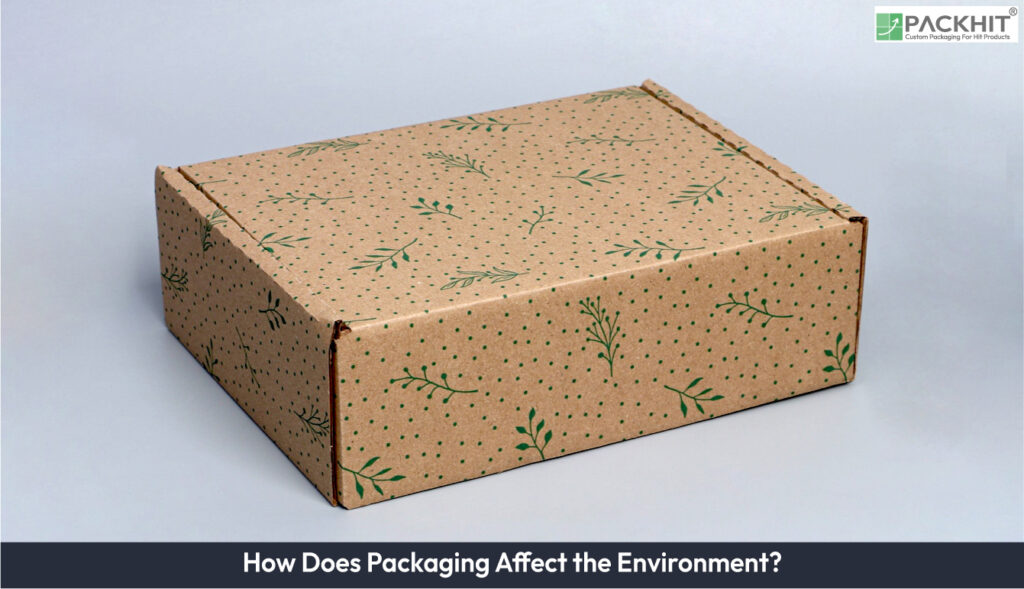Packaging significantly impacts the environment through material usage, production processes, and disposal methods. Traditional packaging contributes to resource depletion, greenhouse gas emissions, and waste accumulation, while sustainable packaging offers alternatives that minimize ecological harm. By integrating eco-friendly materials, optimizing lifecycle efficiency, and promoting circular economy practices, manufacturers can reduce carbon footprints, conserve resources, and align with consumer demand for environmentally conscious products.
What are the Environmental Impacts of Traditional Packaging?
Traditional packaging materials, such as plastics, metals, and non-recyclable composites, have a high environmental footprint. Their production often involves significant energy consumption and the release of greenhouse gases. For example, the manufacturing of virgin plastic emits substantial amounts of carbon dioxide, contributing to climate change. Additionally, these materials are frequently non-biodegradable, leading to long-term pollution in landfills and oceans.
The disposal of traditional packaging exacerbates environmental issues. Non-recyclable materials accumulate in landfills, where they release harmful chemicals into the soil and water. Plastics, in particular, pose a severe threat to marine ecosystems, with microplastics infiltrating food chains and disrupting biodiversity. According to the EPA, packaging waste accounted for 3.6 million tonnes in 2022, highlighting the urgent need for sustainable alternatives.
How Does Sustainable Packaging Minimize Environmental Impact?
Sustainable packaging minimizes environmental impact by addressing key areas such as material composition, lifecycle efficiency, waste reduction, and resource conservation.
Material Composition and Lifecycle Efficiency
Sustainable packaging utilizes eco-friendly materials such as recycled paper, biodegradable plastics, and plant-based composites. These materials are designed to reduce pollution during production, usage, and disposal. For instance, using recycled paper instead of virgin paper can save up to 90% of energy and reduce greenhouse gas emissions by 74%. Biodegradable materials decompose naturally, minimizing long-term environmental harm.
Lifecycle analysis plays a critical role in sustainable packaging. By evaluating the environmental impact from sourcing to disposal, manufacturers can identify opportunities to optimize resource usage and reduce waste. Closed-loop systems, where materials are reused or recycled, further enhance sustainability by promoting circular economy practices.
Waste Reduction and Resource Conservation
Sustainable packaging significantly reduces waste generation by incorporating recyclable, compostable, and reusable materials. For example, post-consumer recycled content (PCR) minimizes reliance on virgin resources, while compostable packaging supports organic waste management. These practices align with consumer preferences, as 76% of buyers actively seek sustainable options.
Resource conservation is another key benefit. By using renewable materials such as bamboo, seaweed, and organic textiles, manufacturers can decrease dependency on non-renewable resources. Responsible sourcing ensures minimal ecological disruption during material extraction, further supporting environmental sustainability.
What are the Challenges in Transitioning to Sustainable Packaging?
Despite its benefits, adopting sustainable packaging presents challenges. Transitioning requires significant investment in new materials, technologies, and processes. For instance, 43% of brands express concerns about the costs associated with switching to sustainable options. Additionally, ensuring compatibility with existing products and maintaining functional requirements can be resource-intensive.
Unintended consequences may also arise. While biodegradable materials reduce long-term waste, their production can involve higher energy consumption compared to traditional plastics. Similarly, the perception of sustainability may be challenged by hidden environmental costs, such as the carbon footprint of transporting eco-friendly materials.
How Does Consumer Demand Influence Sustainable Packaging?
Consumer preferences play a pivotal role in driving the adoption of sustainable packaging. Surveys indicate that 75% of consumers prioritize eco-friendly packaging, with 33% willing to pay a premium for sustainability. This shift in demand encourages brands to align their practices with environmental values, enhancing customer loyalty and brand reputation.
Brands offering sustainable packaging often experience positive market outcomes. For example, companies adopting circular economy principles report increased consumer trust and reduced regulatory risks. By integrating sustainability into their packaging strategies, businesses can attract eco-conscious customers and gain a competitive edge.
What are the Future Trends in Sustainable Packaging?
The sustainable packaging industry is projected to grow from USD 371.4 billion in 2022 to USD 737.6 billion by 2030, driven by regulatory changes and technological innovations. Emerging materials, such as bioplastics and compostable composites, are expected to dominate the market, offering enhanced environmental benefits.
Technological advancements will further shape the industry. Innovations in material science, such as plastics that dissolve in seawater, address critical issues like ocean pollution. Additionally, lifecycle analysis tools enable manufacturers to design packaging solutions that optimize sustainability across all stages of production and use.
Regulatory frameworks will also influence future trends. Governments worldwide are implementing stricter rules to reduce packaging waste and promote recycling. These policies encourage businesses to adopt sustainable practices, ensuring compliance and reducing environmental impact.

